Don’t Let the Pigeon Drive the Bus Play Guide
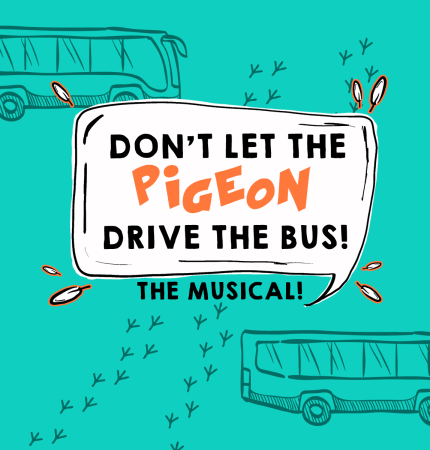
What to know – before the show!
[bs_collapse id=”collapse_5c2b-08d9″]
[bs_citem title=”Play Synopsis” id=”citem_2996-2bf9″ parent=”collapse_5c2b-08d9″]
Our story begins with Pigeon who is upset he must spend yet another day unable to do any of the things he wants to do such as get a hot dog from the Hot Dog Vendor. As he sits, stewing in his misfortune, a City Worker moves Pigeon out of the way in order to place a new bus sign. Pigeon’s annoyance melts away as the Bus Driver arrives in a shiny, beautiful bus. As the Bus Driver sings about how wonderful it is to be a bus driver, Pigeon’s interest is piqued and he decides he wants to drive the bus.
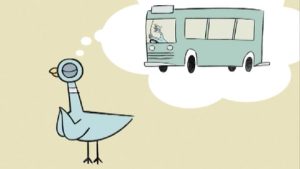
The Bus Driver takes off on her scheduled route while Pigeon gets lost in a fantasy of driving the bus. When he finally realizes the bus is gone, he laments what could have been. Soon the bus returns and Pigeon tries to ask the Bus Driver a question but is interrupted by the passengers – a Businessman, Little Old Lady, and Teenager – arriving to take the bus to their various destinations. The Bus Driver prides herself on never being late but is at risk of being delayed when Pigeon begs to drive the bus, a demand the Bus Driver and passengers turn down.
Pigeon is once again upset that he is unable to do something he wants to do. The Teenager and Bus Driver try to sympathize with the bird by saying that they both always wanted a puppy, but their mothers said they couldn’t because a puppy is a big responsibility. Determined to prove he can do anything he wants with no training, Pigeon leaves to go get a puppy of his own. With Pigeon gone, the Bus Driver remembers that she has a schedule to keep, but when she tries to start the bus, the engine sputters. With the bus unable to start, the passengers panic thinking they will be late and miss each of their activities.
After calming down the passengers, the Bus Driver hands her official bus driver cap to the Teenager and gets to work fixing the bus. Pigeon returns in a panic, as if being chased, which causes the passengers to restart their panicking until they meet Pigeon’s new puppy. The passengers adore the puppy which Pigeon uses as a distraction. As the passengers head off to play with the dog, the Teenager drops the Bus Driver’s cap which Pigeon picks up to wear. He then climbs into the driver’s seat of the bus to attempt to drive only to discover that he can’t because his legs are far too short to reach the pedals.
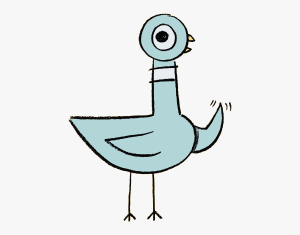
Dejected, Pigeon proclaims that he is broken. The Bus Driver comforts him by telling Pigeon that he’s not broken, he just has to find the right thing for him. She tells Pigeon that before she wanted to be a bus driver, she wanted to fly like a bird. But since she didn’t have wings, she discovered that she could fly down the road as a bus driver. She encourages Pigeon to take a look inside to figure out his thing. The Bus Driver also notes that now that she knows what’s wrong with the bus – a bunch of bird seed is caught in the engine – she needs to restore people’s faith in her. To do this, she asks Pigeon to help her by flying to the various bus stops around town and telling the passengers that the bus is running a few minutes late.
Pigeon then reveals that he never learned how to fly, so the Bus Driver offers to help teach him. Soon Pigeon is flapping his wings and in the air, soaring across town to deliver the message from the Bus Driver. With the news delivered, Pigeon returns to the bus as the Bus Driver and passengers eagerly wait for the engine to start. Once it does, they thank Pigeon and set off on their scheduled route. Pigeon is ecstatic to finally have a thing of his own until the City Worker returns, this time with an airplane sign for the new airport opening nearby. Pigeon gets an idea and begs to fly the plane, a demand everyone turns down.
[/bs_citem]
[bs_citem title=”Play Before the Play” id=”citem_538b-8bcb” parent=”collapse_5c2b-08d9″]
THE PIGEON’S NEXT ADVENTURE
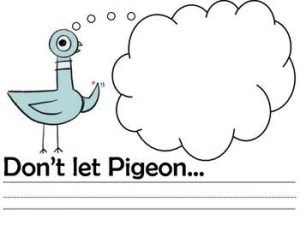
Don’t Let The Pigeon Drive The Bus: The Musical is based on the book written by Mo Willems. He has written several other books about the Pigeon’s many misadventures. Now it is your turn to create the next one!
Have each of your students think of something that they do every day, something that might seem ordinary to them but would be very extraordinary to see a pigeon do. Maybe it’s learning to ride a bike or going to an amusement park. Now have your students write and illustrate their own story with the Pigeon doing the activity they decided on. As they work on their stories, encourage students to think about how the Pigeon might react to this activity. How might other people react to seeing a pigeon doing that thing? What funny problems might arise for the Pigeon and everyone around him?
After everyone has finished their writing their story, have them share their creations with the class.
KAS: VA:Cr.1.1.1; C.1.3; VA:RE7.2.K
VERY CURIOUS, INDEED
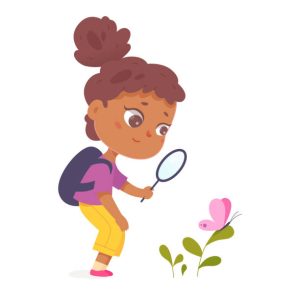
In the musical, the Pigeon demonstrates a lot of passion and curiosity as he pursue his desire to drive a bus. But birds aren’t the only ones who express curiosity. People can be curious and have a passion to try new things too!
Have each of your students make a list of three things that they want to try or know more about such as learning how to do a cartwheel or discovering how astronauts are chosen to go up to the International Space Station. Once each student has their three things, have them do a little research and/or make an action plan to start learning more about the things on their list. Have students share their lists with each other. For added fun, set a deadline for your students to complete an item on their list. Then have them share what they’ve learned with their classmates on your selected date in the form of a show and tell presentation of drawings, photographs, a short oral report, or even a demonstration of their newly acquired skills.
KAS: C.1.3; VA:Cr1.2.1
[/bs_citem]
[bs_citem title=”Contextual Article” id=”citem_8295-0686″ parent=”collapse_5c2b-08d9″]
THE BIRD IS THE WORD: THE PLIGHT OF THE DOMESTIC PIGEON
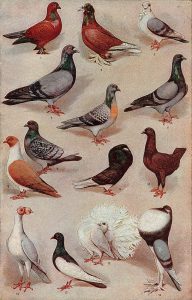
You’ve seen them. They can be found in most urban areas all over the world leaving a mass of feathers and droppings in their wake as they boldly forage for food and roost amongst city buildings seemingly without a care. They’re pigeons, and with an estimated population of nearly 400 million worldwide, they are often considered a pest problem. But why?
Pigeons have a lengthy history of domestication and engagement with humans. We’ve used them as sources of food, entertainment (such as pigeon racing), and messaging for thousands of years. The feral pigeons we see today are descendants of escaped flocks from the family Columbidae, commonly known as rock pigeons, rock doves, or common/domestic pigeons. Because of their roots in domestication and forced breeding by humans, pigeons come in a variety of colors and feathered looks.
Rock pigeons made their nests on the sides of rocky cliffs, but with the expansion of cities, pigeons have adapted to use buildings and window ledges that mimic the rocky cliffs their ancestors would have inhabited. Some breeds of rock pigeons were known for their incredible homing abilities which allowed them to find their way back home from long distances at high speed. Nowadays, common pigeons are quite sedentary and rarely leave the areas where they’ve settled. In some cases, when feral pigeons are involuntarily relocated, they can find their way back to their original location within hours.
Humanity’s relationship with pigeons started out favorably. While chicken and geese were domesticated earlier than pigeons, in the Middle East and Europe, pigeons were the dominant bird used for meat for thousands of years. Humans loved breeding the species for their fashionable feathers, and they made wonderful messengers long before the advent of technology like phones and the internet. Pigeons didn’t make their way to North America until the 1600s, but much like the rest of the world, we saw them favorably at first, too. But as more and more domesticated pigeons found their escape, they’d breed with wild rock dove populations creating the rampant flocks of common pigeons we have today.
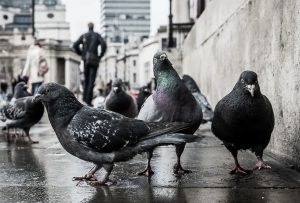
Over time, humanity began to see pigeons as pests rather than pals. In the 1930s and 40s, pigeons began earning a poor reputation in newspapers. Then, in 1963, public disdain for pigeons truly took off when the species was blamed for two human deaths, citing the spread of diseases. Ever since, pigeons have been referred to as “rats with wings.” However, humanity’s disdain for pigeons is a bit misguided. The risk of pigeons being harmful to the health of humans is quite uncommon, and while pigeons can contract illnesses such as West Nile Virus and bird flu, they don’t appear to spread them to other birds making them safe to the health of various bird species, too.
If anything, pigeons may simply be misunderstood. Sure, their abundance of feathers and droppings are often a source of distasteful artistry against city landscaping, but the truth is that humans domesticated pigeons then cast them aside and have left them to their own devices. It’s no wonder why pigeons are so comfortable around humans. They need us for survival after thousands of years of friendship. Hopefully one day, humans and pigeons can learn to live in harmony once more. [/bs_citem]
How to grow – after the show!
[bs_citem title=”Extend the Experience” id=”citem_c36d-1f1f” parent=”collapse_5c2b-08d9″]
LET’S ALL DRIVE THE BUS
After hearing so much about driving a bus, it’s time to allow your students to drive one themselves. Give each student a paper plate. This will act as their bus steering wheel. (You can pre-cut the plates for them by cutting out the center circle of the plate. Prep two strips and one small circle for the middle of each steering wheel.) Allow students time to decorate their wheel in any way they would like using crayons, stickers, mosaic paper, and other craft supplies. Once the steering wheels are finished, it’s time to drive the bus!
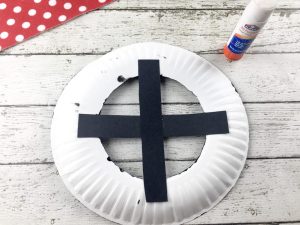
Have each student begin to “drive” their bus. This can either be done sitting down or walking around the room. Give students a quick driving lesson and teach them basic commands such as stop, go, blinker, etc. Have students practice using these simple commands to help them avoid collisions while “on the road.” You can even treat it like a game of Simon Says. Then ask students what sort of people they might find to ride on their bus. In LCT’s production of Don’t Let the Pigeon Drive the Bus, there were many different people in need of a bus ride like the businessman trying to get to work or the little old lady trying to get to the hospital to see her newborn grandchild. Divide your students into small groups and have some be bus drivers and others be passengers. Allow time for your students pick up some passengers and take them where they need to go. Once they are all dropped off, switch roles so everyone has a chance to be a bus driver and a passenger. Once everyone has driven their bus, it’s time to park the bus and call it a day!
Now have your students sit down and write a short story about their day as a bus driver. What did they see? Did anything strange happen on their route? Did they enjoy being a bus driver? Share the responses with the class.
KAS: VA:Cr2.3.2; VA:Cr1.2.2; TH:Cr1.1.K.a
IT TAKES A VILLAGE
When the bus breaks down in Don’t Let the Pigeon Drive the Bus: The Musical, it creates a lot of problems. Even in real life, many people rely on the public bus system to get around. But that isn’t the only public service we rely on. Take some time with your class to brainstorm other public services that we count on every day (i.e. Teachers, Waste Management, Firemen, etc.). Discuss why those people and services play a crucial role in our communities. What would happen if we didn’t have such services and individuals in our communities?
Now, have your class write a thank you note to some of these community heroes. Encourage students to express their gratitude through pictures and heartfelt words. Then help students deliver their letters to the intended party whether by mail (another great public service) or in person.
KAS: K.I.Q.1; C.1.1; VA:Cr1.2.2
FLY OFF, BIRD!
When characters in a story want something, they have what’s called an objective or a goal. When they try different ways to achieve their goal and get what they want, they use things called tactics. Tactics are actions one can do such as ask, bribe, flatter, etc. In the musical, Pigeon wants to do a lot of things. His objective is to drive the bus. He begs, his primary tactic of choice, but is still met with a resounding “no” by the Bus Driver because her objective is also to drive the bus. Now Pigeon has an obstacle, something that stands in the way of what he wants. This is where conflict, or the problem, arises.
After introducing your students to the vocabulary words objective, tactic, obstacle, and conflict, tell your class that they are going to take on the roles of Pigeon and the Bus Driver. Start by making a list of tactics with your students and explain what each tactic might look like. Below are a few examples your students may have already heard of:
Ask, Reason, Beg, Flatter
Bribe, Annoy, Threaten
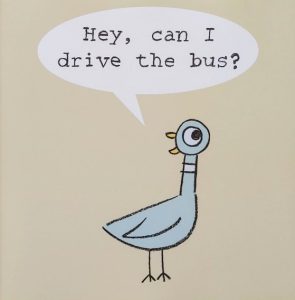
Then put students into pairs. Have one student begin as the Bus Driver and the other be the Pigeon. The Bus Driver’s objective is to not let Pigeon drive their bus. Have the Bus Driver secretly choose a tactic from the list. This tactic, which they should keep to themselves, is the only tactic that will work to get them to let the Pigeon drive the bus. Then have the Pigeon choose a tactic to try. If the tactic the Pigeon chooses to act out doesn’t match the one the Bus Driver secretly chose, then the Bus Driver will say no and the Pigeon should try a different tactic. If the tactic matches, the Bus Driver will say yes, and the Pigeon will be able to drive the bus. Allow students to guess the right tactic 3 times before having students switch roles so they can be both the Bus Driver and the Pigeon.
To help students get the hang of the activity, do an example run where you are the Bus Driver. For this example, you’ll use choose flattery for your tactic. Then choose a volunteer to play the Pigeon. Have them pick a tactic from the list to try and tell you what it is. Review how that tactic might look. For instance, if they choose beg as their tactic, they may get on their knees and plead with you to drive the bus. Once they know what actions to do, have the student try the tactic. If they chose to beg, say no because that’s not the correct tactic and let another volunteer try. Ultimately get the students to choose flattery. They may tell you that you’re the best Bus Driver ever and that your bus is the only bus in town worth riding. Then when they ask if they can drive the bus, you’ll say yes because they used the correct tactic.
Extend the Experience: For added fun, have your students create short scenes in which the Pigeon tries out a tactic or two of their choice. The Bus Driver should stand their ground and not let the Pigeon drive no matter how convincing the Pigeon might be. Have students share their short scenes with the class and ask the audience to identify what tactics the student playing the Pigeon used. If all your students can keep the Pigeon from driving the bus, reward them with an official certificate from Mo Willems, author of Don’t Let the Pigeon Drive the Bus!
KAS: TH:Cr1.1.3.a; TH:Pr4.1.1.b; TH:Cn11.2.1.b
[/bs_citem]
[bs_citem title=”Suggested Reading” id=”citem_5d0b-3b30″ parent=”collapse_5c2b-08d9″]
If you like books with animals on comedic adventures, you may also like…

The Pigeon Finds A Hot Dog by Mo Willems
Pigeon learns about sharing when a curious duckling keeps asking questions about the hot dog Pigeon has found.
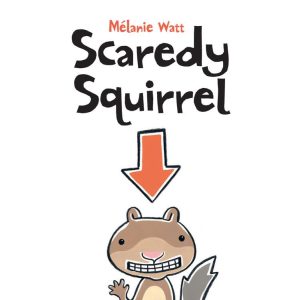
Scaredy Squirrel by Watt Melanie
The first book in the Scaredy Squirrel series is a comical story of an endearing squirrel who learns what can happen when he’s brave enough to take a risk.

There’s a Bear on My Chair by Ross Collins
Poor Mouse. A pesky bear has settled in his favorite chair, and that chair just isn’t big enough for two.
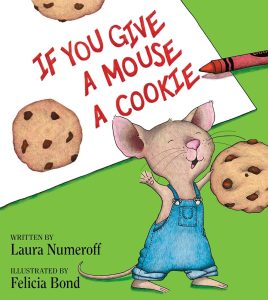
If You Give a Mouse a Cookie by Laura Joffe Numeroff
If a hungry little traveler shows up at your house, you might want to give him a cookie. But remember that giving him a cookie comes with some never-ending consequences. [/bs_citem]
[/bs_collapse]


